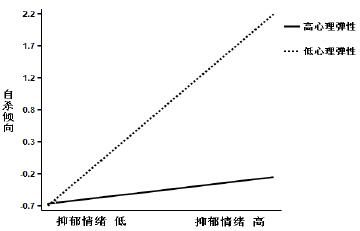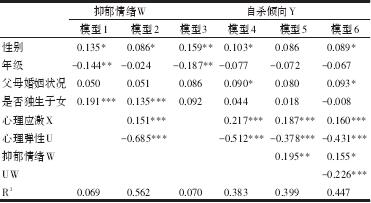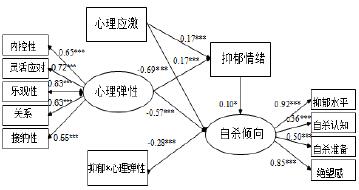Suicide is the result of the comprehensive function of physical, psychological, social and cultural factors. Definition of suicide (suicide Inclination) individuals experience suicidal behavior motivation and trend, individual due to some reason intend to suicide or preparations for the implementation of suicidal behavior of a kind of mental activity, with persistence, hidden, extensive and chance, it is suicide has hence beyond all other phenomena associated with suicide, including suicidal ideation and suicide attempts [1]. According to the American College Health Association (American College Health Association data show, in the past 60 years, teen suicide rate increased 3 times, has become the third leading cause of death in 15 - to 24 year olds, become the cause of death for college students is the third leading cause of [2, 3]. Another data show that as many as 50% of college students have different degrees of suicide ideation, 8-15% of them in different ways to implement the suicidal behavior [4]. Therefore, college students are more susceptible to suicidal, so it has important significance to investigate the mechanism of the effect of the suicidal tendency of college students.
Psychological stress, psychological stress or called "stress", namely a person in awareness or recognize himself facing the crucial and difficult to deal with the environmental requirements, produce a tendency through all sorts of psychological and physiological responses and psychological state of tension [5]. It is an inevitable problem in one's life, and has become one of the most prominent psychological health problems of the contemporary [6]. Stressful life events were significantly associated with depression and depressive symptoms in [7], about 20%-25% of individuals who experienced a strong stress event developed into depression [8]. While previous studies have proved that depression can significantly predict suicidal [4]. In addition, studies have shown that stress with suicidal ideation is significantly associated with [9, 10], and stress intensity is a major risk factor for suicide [11]. Based on this, this study suggests that depression plays a mediating role between psychological stress and suicide.
However, as is known to all, and not all depression of individual suicides. This shows that there are protective factors regulating the relationship between depression and suicide, such as resilience, but in previous studies, resilience neglected [12]. Resilience (Resilience) is an individual's personality trait, which can help individuals recover from the psychological trauma caused by these stress events, and then return to the functional state of stress in the event of major stress events. [13]. Positive emotions, cognitive flexibility, meaning construction, and positive coping are all aspects of resilience, resilience plays an important role in protecting individuals and reducing the negative effects of depression [14]. However, when the individual level of resilience is low, it can not protect the individual, reduce the negative impact of depression. Based on this, this study suggests that resilience play a regulatory role in depression and suicidality among.
In summary, this study to college students as the main object, explore depression and resilience in psychological stress and suicidal mechanism. This research draws the following assumptions: in psychological stress for suicide and depression play a mediating role, namely psychological stress through the influence of depression of college students are more likely to commit suicide, resilience and the regulatory role, between the four is the mediating relationship.
1, objects and methods
1.1, object
In the north and south each take a college, randomly selected the school elective class, issued a total of 850 questionnaires, a total of 713 valid questionnaires were recovered, the effective rate of 83.88%. Among them, 342 boys, 47.97% of the total number of girls, 362 people, the total number of 50.77%, the default 9 people, accounting for 1.26% of the total number. The age was between 17-34 years old, the average age was 21.25 (SD=2.89) years old.
1.2 tools
1.2.1, psychological stress scale using Liang Baoyong and Hao Zhihong [6] prepared by the Chinese college students' psychological stress scale, the scale contains 85 items, each item from the "minimum" to "maximum" 7 grade. All project is divided into the academic component table, life subscales, development scale and subscales of social and family subscale, life events subscales and the daily chores component, total score said individuals to bear the psychological pressure, score higher, indicating that the individual bearing is governed by the total psychological pressure is greater. The internal consistency reliability of the scale in this study was 0.959.
1.2.2, self rating depression questionnaire using Zung[15] prepared by the self rating depression scale. This scale includes 20 items. Each item is equivalent to a related symptoms that follow from the occasional or no "to" often "4 grades. The higher the total score, the more serious the individual depressive mood.
1.2.3, Mental Resilience Scale using conditions and Cheng Cheng [13], such as the establishment of Chinese adults with Mental Resilience Scale. The scale included 30 items, each item from "completely do not conform to the" to "full compliance" 4 grades. The higher the total score, the higher the level of psychological characteristics that help individuals recover from the psychological trauma caused by the major stress events such as adverse events, disasters, loss or threat.
1.2.4, suicidal tendencies questionnaire by Zheng Aiming, Tu Nong Chen and Zhu Tingting [1] the establishment of suicidal tendency of college students questionnaire, to measure whether the individual has suicidal tendencies. The scale consisted of 34 items, each item from "never" to "always" 4 grades. The project shows that the higher the score, the more severe suicidal individuals.
1.2.5, control variables in the study of variables that may have an impact on the study variables, such as gender, grade, parents' marital status and whether it is the only child. Method for the quantification of demographic variables: gender variable definition: 1 male and 2 female; "grade" variable is defined as: 1 for the first grade, second grade 2, 3 for the third grade, 4 grade four; "marital status" variable is defined as: 1 for good, 2 for the general, 3 for the poor, 4 is a divorced; "whether singleton variable definition: 1 is, 2 is not.
1.3 data processing and analysis
After the questionnaires were collected, the questionnaires were deleted and the valid questionnaires were carried out in order to carry out the encoding, the SPSS16.0 was recorded and analyzed, and the fitting degree of the model was verified in AMOS17.0.
2, knot fruit
2.1, the present characteristics of the suicidal tendency of College Students
According to Zheng Aiming [1], who designed the suicidal tendency questionnaire, total score is more than or equal to 76 points for a high packet determine marked tendency; 52 points < total <76 determine suicidal suspicious; score less than or equal to 52 points for low achievers, judge no suicidal. The total of 713 subjects and suicidality scores was 50.0%, the marked tendency to have 13 people, accounting for 1.8% of total subjects were the number of; suicidal suspicious has 208 people, accounting for 29.2% of total subjects were the number of; suicidal tendency has 492, accounted for 69.0% of total subjects number.
2.2, the relevant analysis of the research variables
Table 1 lists the mean, standard deviation, and the correlation coefficient between the variables. Correlation analysis. Result showed that the psychological stress, depression, resilience and suicidal four variables between pairwise correlation, the correlation coefficient between -0.086 -0.671 Among them, the same psychological stress and depression were significantly positively correlated with suicidal resilience significantly negatively correlated.

Table 1 mean, standard deviation and correlation coefficient (N=713) of the study variables.
2.3, there is regulation of the intermediary role analysis
According to Muller, Judd and Yzerbyt[16] as well as Ruck, er, Preacher and Hayes[17] tests "have the mediation effect" of the step. Multiple regression analysis was used to test the hypothesis, and table 2 showed the result of stepwise regression. Before making a return, the central processing was done on other variables except for demographic variables such as gender, grade, parents' marital status, and whether the only child. In each model, the control variables (gender, grade, parents' marital status, and whether the only child) were used as the first step into the model (see model 1 and model 3), and then the variables entered into the model. According to the inspection procedure regulated intermediary: do suicidal regression on the psychological stress and elastic coefficient (see model 4), psychological stress significantly (P =0.217, t=4.830, P<0.001); regression of depression on the psychological stress and elastic coefficient (see model 2), psychological stress significantly (beta =0.151, t=3.989, P<0.001); return to do suicidal psychological, elastic and depression (see model 5), the coefficient of depression significantly (P =0.195, t=3.989, P<0.01); return to do suicidal psychological, elastic, depression and resilience and depression (* see model 6), the coefficient of resilience * depression significantly (P =-0.226, t=-5.305, P<0.001), hypotheses are verified.
Table 2 multiple regression analysis

To more clearly demonstrate regulatory role of resilience of variables, this study will reference suggestions on grouped Aiken and West[18], will be lower than the average of resilience 1 standard deviation divided into "low resilience group", and higher than 1 standard deviation for "high resilience group". From Figure 1 it can be seen, whether it is the high level of resilience or to the low level of resilience, with increasing levels of depressive mood, suicidal also increases and levels of depression and suicidal tendencies in the low level of resilience (simple slope=1.989, t=7.958, P < 0.001) ratio (simple slope=1.680, t=8.109, P < 0.001) relationship is stronger, namely that for low resilience group, the effects of depression on individual stronger, the possibility of suicide attempts was more.
Figure 1 resilience in the regulation of the effect of depression and suicidality among

2.4 data fitting and verification
The structural equation model was verified by AMOS 17 statistical software in order to test the mediating effect of the hypothesis model. The results are as follows: X 2=96.455, df=41 x 2/df=2.353, CFI=0.982, NNFI=0.971, SRMR=0.032, RMSEA=0.044. The results show that the fitting parameters of the model meet the statistical requirements, the data fitting is better, and the structural equation model is shown in figure 2.

Fig. 2 the structure equation model of the mediation effect
3, discuss
The results of the study show that in psychological stress for suicidal effect mechanism and depression play intermediary role, resilience regulatory role, between the four is the mediating relationship.
First of all, depression plays a mediating role between psychological stress and suicidal tendencies, with previous research results [19]. Psychological stress occurs when the individual thinks that the environment is too heavy for them, even beyond their ability to adapt. In general, stress events have caused the individual negative negative emotions (e.g., anxiety and depression) [20]. And when the level of psychological stress increases, the level of depression also increases.
While depression and suicide were significantly associated with [21], depression was a major risk factor for suicide [22]. It is estimated that 80% of individuals with depression have committed suicide [23]. Based on recent research and demographic data, if effective prevention and treatment of depression, the 40%-50% will be able to reduce the individual suicide ideation and suicidal behavior [24]. So, why do individuals with depression commit suicide? According to Beck's theory, depression is made up of three basic components, which are three elements, schema and wrong cognition. Among them, the cognition of the three elements is composed of error perception. Specifically, cognitive distortions, cognitive deficits, wrong world views and future views (the world is very horrible, do not believe in the future will be better). All of these experiences have made the individual depressed. At the end of the last, these consistent logic errors make the individual cannot identify the information that is contrary to his beliefs. Therefore, the individual can only commit suicide to get rid of the hopeless and can not change the life of 26], [25. Therefore, for college students suicide crisis intervention, but also to focus on the depression may increase the probability of suicide attempts, highly concerned about the individual with depression, reduce the occurrence of suicidal behavior.
Secondly, resilience in depression and suicidal thoughts play regulatory role, relative to the low level of resilience of individuals, the individuals with high level of resilience and the relationship between depression and suicide weaker. This same et al Johnson[27] research results consistent. Resilience eased the depression has significant impact on suicide, weakens the effects of depression on the suicidal tendencies and reduce the risk factors for suicide. Resilience not only with suicidal negative correlation, and regulating the effects of depression on the individual, reduce the suicide behavior of an individual. The individuals with higher levels of psychological flexibility can better call their social support system to cope with the difficulties and adapt to the environment, so as to protect their own mental health [28]. Some scholars also mentioned in the study, clinical workers have found that the relationship between the level of mental flexibility and suicide. In general, the level of psychological resilience of individuals attempting to commit suicide is low [29]. Should therefore be attaches great importance to the resilience of the role, and strive to improve the resilience of college students level, reduce the negative effect of depression on suicidal.